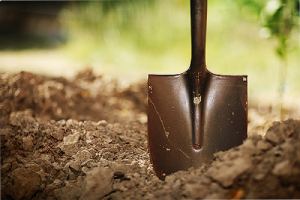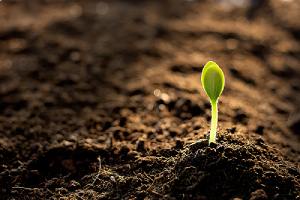 Soil acidity refers to how acidic or alkaline the soil in your lawn and garden is. Soil that is highly alkaline or acidic will make growing flowers, plants, shrubs and even trees difficult. Instead, lawn and garden owners should understand how to reduce soil acidity in order to strive for neutral soil.
Soil acidity refers to how acidic or alkaline the soil in your lawn and garden is. Soil that is highly alkaline or acidic will make growing flowers, plants, shrubs and even trees difficult. Instead, lawn and garden owners should understand how to reduce soil acidity in order to strive for neutral soil.
Soil acidity is measured by the pH scale. The scale ranges from 1 to 14. Higher numbers indicate soil that is alkaline and lower numbers indicate soil that is acidic. The preferred soil pH depends on what is being planted and the purpose for the lawn and garden. In most instances, a soil level between 6 and 7.5 is ideal.
If the soil goes too far below 6 — meaning it is highly acidic — then plants may fail to grow. In this case, reducing the soil acidity may be necessary. The following is a review of how to test your soil acidity, determine if lowering the soil acidity is necessary and steps to take to ensure you are able to achieve the ideal pH level for your lawn and garden.
Testing Your Soil’s pH Levels
Before you change your soil pH level, you should first accurately determine what the pH level is. There are several ways to test your soil acidity The three most common methods include:
Vinegar And Baking Soda Test
Mix soil and water together in a clean bowl and add vinegar. If the soil bubbles, then it is alkaline. If not, repeat the process with baking soda. If the soil bubbles, then it is acidic.
Store-Bought Testing Kits
You can get pH testing strips in many gardening centers. Follow the supplier’s instructions closely and test various areas of your lawn and garden to get an average pH level of your soil.
Professional Testing Kit
Professional testing kits involve taking a sample of your soil and mailing it to a testing facility. They can give you a precise indication of your soil pH as well as provide you with more details about the nutrients of your soil.
A store-bought testing kit is less reliable than a professional testing kit, but it should provide a fairly accurate idea of the level of your soil pH. Vinegar and baking soda tests are the least reliable as human error is more of a concern, although it can provide an idea of your soil pH as well if done correctly.
Adding Limestone
 Limestone is the most common way to raise soil pH. You can find limestone at many garden centers, and it is relatively affordable. There are two main types of limestone for reducing soil acidity — calcitic limestone and dolomitic limestone. Calcitic limestone contains calcium carbonate and dolomitic limestone contains magnesium. Limestone products come in various forms. Among the most notable types of limestone for reducing soil acidity are:
Limestone is the most common way to raise soil pH. You can find limestone at many garden centers, and it is relatively affordable. There are two main types of limestone for reducing soil acidity — calcitic limestone and dolomitic limestone. Calcitic limestone contains calcium carbonate and dolomitic limestone contains magnesium. Limestone products come in various forms. Among the most notable types of limestone for reducing soil acidity are:
- Pulverized
- Pelletized
- Granular
- Hydrated
Pulverized limestone is the most common. It comes in powder form. Many prefer it due to its fast-acting abilities. Granular and pelletized are the second most common form. They spread very easy but do not have the fast-acting capabilities like pulverized and hydrated forms. Hydrated limestone can take effect even faster because of its strong properties. However, hydrated limestone is not typically recommended for those who have little experience as too much use of hydrated limestone can damage the soil.
For best results, allow limestone to take effect deep into the soil, rather than laying the limestone on the topsoil only.
Spreading Wood Ash
Wood ash is less effective than commercial limestone products. However, if you want an organic method of lowering your soil’s pH, then wood ash is worth considering. The primary drawback to wood ash is it can take more than a year to see a significant change in your soil acidity. With that said, wood ash is effective in lowering soil acidity when applied properly over an extended period of time.
Methods for laying wood ash to reduce soil acidity vary. The simplest way to achieve quality results is by applying a small amount (approximately half an inch) of wood ash to the soil routinely. You can use wood ash from your fireplace, if possible. The key to this method is patience as results may not come as fast as it will with a limestone product.
Of course, you should only choose the wood ash method if you have time and are willing to wait. If you desire faster results, then a type of limestone may be a more appropriate solution. When in doubt as to whether limestone or wood ash is the method for reducing soil acidity in your lawn or garden, contact soil experts to discuss the specific details about your soil and pH levels.
Reasons To Neutralize Soil Acidity
 The ideal soil pH for most soil is between 6 and 7.5. This range includes slightly acidic soil to slightly alkaline soil, and as close to neutral as possible. Although every plant is unique, most grow their best when the soil is neutral. If the soil becomes too acidic or too alkaline, then the plants may not be able to absorb the nutrients properly, which leads to them to not grow properly or die.
The ideal soil pH for most soil is between 6 and 7.5. This range includes slightly acidic soil to slightly alkaline soil, and as close to neutral as possible. Although every plant is unique, most grow their best when the soil is neutral. If the soil becomes too acidic or too alkaline, then the plants may not be able to absorb the nutrients properly, which leads to them to not grow properly or die.
Of course, every lawn and garden owner should evaluate their own plants, shrubs, trees, etc. and research the ideal pH levels they should aim for. If the soil is too acidic or too alkaline, then taking action to reduce or increase the soil acidity may be necessary, although staying at a neutralize soil acidity is often the safest way to ensure proper plant growth.
Contact The Soil Experts
Here at Dirt Connections, we take pride in our knowledge and experience with soil. We will be glad to provide answers if you have questions about how to achieve the ideal soil pH for your lawn and garden, and we can provide you with quality soil (and other products and services) to help as well. We are available by phone and email, and you can reach out to us at any time for a prompt reply. Additionally, you can purchase topsoil through our checkout portal online.
Summary

Dirt Connections was started with one goal in mind: providing quality residential and commercial construction services to clients on time and on budget. Reach out for more information on how we can support your next project.
For your convenience our estimates are free and by appointment. Call 703-940-9949 for a free estimate today!









































